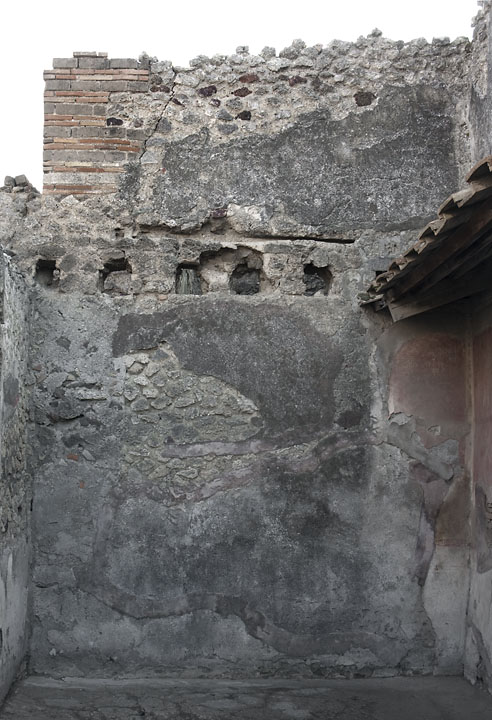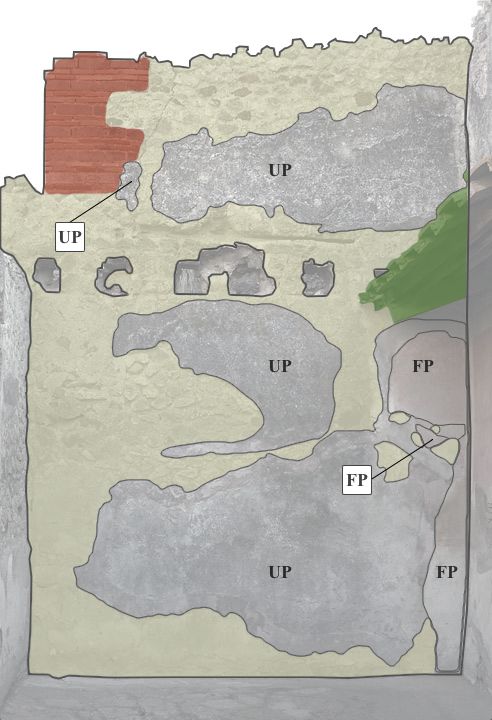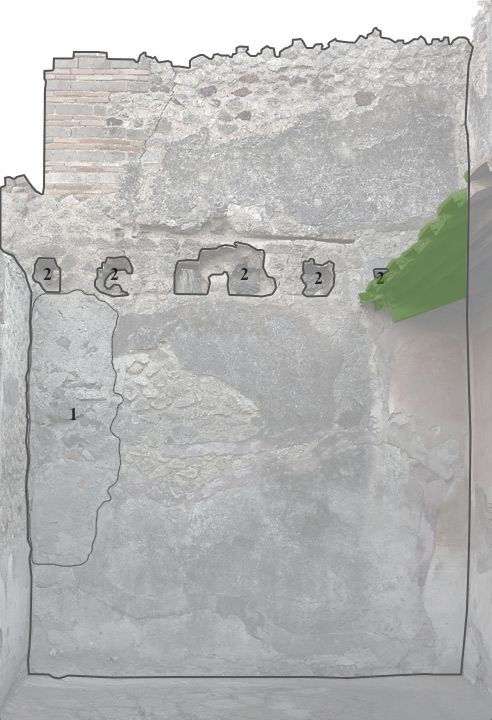East Wall
Description
Mats Holmlund
Ground floor
(above beam holes and down)
The wall is built in opus incertum. It's approximately 3.30 m wide and 2.95 m high. It consists mainly of limestone, but there is also some lava, tufa and cruma.
The wall itself is largely covered by plaster but seems homogeneous, apart from a repair in the north corner. Obviously a hole into room 6 of V.1,3 has been mended. The "breached area" is about 0.75 m wide at its widest point and 2.10 m high. It begins 0.85 m from the floor and ends at the top of the wall.
Apart from that, there are some spolia in the wall. Circa 0.75 m from the north corner and 2.10 m from the floor, there's a piece of limestone with remnants of wall plaster attached to it. Also, in the breached area, there are three pieces of pottery stuck in the mortar. The first is located 0.25 m from the north corner and 1.60 m from the floor, and the second is located 0.45 m from the north corner and 1.65 m from the floor. Both pieces of pottery seem to be parts of an amphora. Directly above the second piece of pottery, there is a third one. It curves and seems to be a part of the neck of an amphora. "Scattered" in the mortar of the breached area, there are also some pieces of tile, and circa 1.00 m from the north corner, directly below the beam holes, there is another piece of roof tile stuck in the wall.
The mortar of the wall is yellowish grey and contains (chiefly) grains of lava and limestone, but also some random pieces of terracotta. In the breached area, there's a layer of light grey, modern mortar applied to the wall. However, between 1.95 to 2.25 m from the floor, there's a gap where this mortar is partially missing and the underlying wall is exposed. At the bottom of the breached area, the light grey mortar is quite smooth, but closer to (and above) the gap the mortar is coarser and contains rather large pieces of lava, lapilli and limestone (and some grains of terracotta).
In the "gap", circa 1.55 m above the floor, there is a semi-circular segment where the mortar is dark grey and contains mostly grains of lava and some limestone. This mortar has supposedly been applied to the wall in recent times to prevent it from eroding. The area is approximately 0.30 m wide and 0.50 m high, and it continues to the north wall.
The remaining wall plaster can be divided into four areas. The first area is approximately 2.75 m wide, between 0.70 and 0.90 m high and begins at the floor. It stretches from the north corner to circa 0.60 m from the south corner of the wall. Its highest point is in the north corner and from there it slopes in "waves" to its end. The plaster is badly weathered but was originally white. The area is held in place by modern mortar that seems to have been applied at two different occasions since one part of the mortar is grey and the other is pinkish. The grey part of the modern mortar is limited to the northern corner and only spans 0.35 m. The pinkish mortar surrounds the rest of the area and also continues around the second area of wall plaster.
The second area of plaster is located in the lower part of the middle of the wall and is adjacent to the first area. It stretches from 0.60 m from the north corner to circa 0.20 m from the south corner, and from the floor (in the south corner) up to circa 1.80 m at its highest point. The only thing remaining in this area is the subsurface of the wall plaster, and in the south corner it's superimposed by the third area of wall plaster (which indicates that the third area actually is a part of the "painted" plaster layer that originally covered the entire wall). There are traces of cuts in the subsurface. The cuts are mainly located at the bottom part of the area (from the floor and up to circa 0.60 m). The area is fixed to the wall by a band of pinkish, modern mortar.
The third area is located in the south corner of the wall and it can be divided into two segments: The first segment stretches from the floor up until 1.90 m and is between 0.05 and 0.40 m wide. The paint and decoration of the plaster is still preserved and is of the same type as on the south wall - though it is offset (higher) by a margin of 0.01 m (for further information of the decoration, see the description of the south wall decoration). The yellow decorative band is hardly discernable, but markings in the plaster indicate where it would have been. From 0.75 m above the floor and up until 1.45 m the plaster is held in place by the same band of pinkish, modern mortar that surrounds the second area of wall plaster. From 1.45 m and to the top of the segment, the band is grey. The second segment of the third area begins 1.95 m from the floor, and from there, it stretches a further 0.75 m up and out 0.65 m from the south corner. Both segments are rather fragile where they join together and pieces of plaster have fallen from the wall, exposing the plaster subsurface beneath.
The fourth area of wall plaster is located in the upper part of the middle of the wall. It starts circa 0.75 m from the north corner and 1.80 m from the floor. It is approximately 1.50 m wide and 1.05 m high, and is fixed to the wall by a band of pinkish mortar. A large part of the area has collapsed (it's circa 1.00 m wide and at its highest point 0.80 m high), exposing the incertum wall behind it. The area itself is badly weathered and consists only of plaster subsurface.
Upper floor (room 2 & 3)
The wall is completely built in opus incertum, except for a doorway to/from room 6 of V.1,3, that's built in opus listatum. It's approximately 4.45 m wide (which is much wider than the first floor east wall) and since the south doorpost is located above the partition wall between room 2 and 3, the second floor of room 2 must have spanned across room 3 as well. The wall is circa 2.00 m high in the north corner, 1.55 m high at the south doorpost, and 1.85 m high in the south corner. The listatum part of the north doorpost is circa 0.30 m wide and the south one is circa 0.80 m. The south doorpost is crenelated. The door, itself, is approximately 0.80 m wide.
There's a row of beam holes located circa 2.95 m above the floor. The individual holes vary in size and are between 0.15 to 0.25 m wide and 0.25 and 0.35 m high (the beam holes probably belongs to room 7 in V.1,3 and not to room 2). There's a modern repair at the south end of the row of beam holes that's related to the protective roof of the first floor south wall of room 2.
From approximately 0.60 m from the south doorpost and to 0.90 m from the south corner, there is a circa 1.80 m wide, between 0.04 and 0.22 m high, and 0.14 m deep cavity. The cavity is located directly above the row of beam holes and maybe related to the floor of the second floor.
There are no signs of spolia in the wall, except for a small piece of terracotta circa 0.65 m from the north corner and 0.20 m below the threshold of the doorway. The threshold is located circa 0.50 m above the beam holes.
In some areas there's ash and lapilli stuck to the wall. The first instance is located at the north doorpost, below the threshold, and is circa 0.25 m wide and 0.30 m high. The second is located above the partition wall and is approximately 0.60 m wide and 0.30 m high. The last instance is located in the south corner, is circa 0.10 m wide and 0.75 m high.
The mortar of the wall is yellowish grey and contains grains of lava and limestone.
The north doorpost and the area below the threshold are partly covered by wall plaster. The same goes for the part of the wall, south of the doorway, which is also partly covered by wall plaster. This area starts 0.60 m from the south doorpost and stretches to the south corner of the wall (making it circa 2.70 m wide). By the doorway the area is circa 0.40 m high and in the south corner it is approximately 1.55 m high. All areas are badly weathered and the only thing remaining is the subsurface of the plaster.



